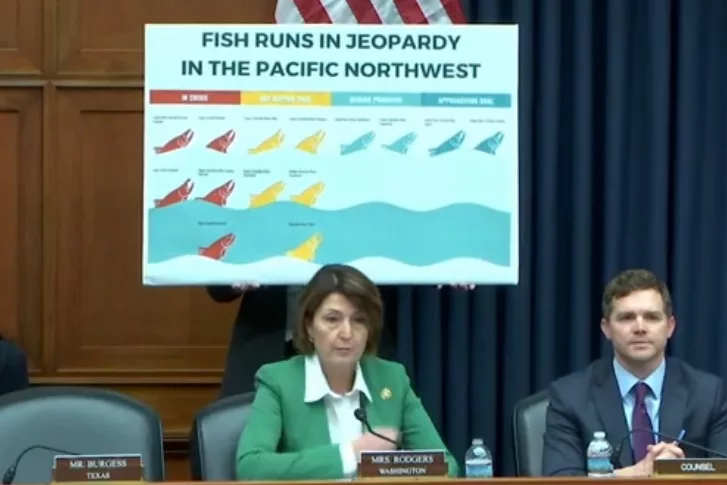Below are Rodger’s opening remarks as prepared for delivery:
“Thank you, Mr. Chairman.
“The Columbia River System is the beating heart of the Pacific Northwest. This critical infrastructure helped transform our region into one of the most productive agricultural regions in the world.
“It serves as a super-marine highway for farmers to ship their products all across America, while keeping thousands of trucks off the road every year. The dams along the Lower Snake River have strengthened our energy grid, lowered energy costs, and made us a leader in reducing carbon emissions.
“They help prevent life-threatening blackouts during extreme weather not just in Washington state but in California, Idaho, Oregon, Montana, and Wyoming, and support a thriving tourism economy and small businesses. They even protect parts of our region from devastating floods.
“To put it simply: the Columbia River System is critical to our entire way of life.
MISGUIDED MEDIATION AGREEMENT
“Unfortunately, some people don’t see it that way, including a few of our witnesses here today.
“For more than two years, the Biden administration worked behind closed doors with a select group of radical environmentalists to develop a secret package of actions and commitments that would temporarily settle litigation over the future of our river system.
“The agreement was released last month, and I’m deeply concerned it advances efforts to remove the four Lower Snake River dams.
“While the administration will say only Congress has the authority to breach the dams, they wasted no time entering into commitments that bypassed Congress and agreeing to spend more than $1 BILLION dollars to achieve their political goal.
STAKEHOLDERS SILENCED
“What’s worse is that despite my repeated calls for transparency, the White House actively and deliberately left out the voices of those who depend on the river system most. Dozens of stakeholders and utility companies practically begged to be heard in this process only to be turned away, shut out, and ignored.
“I’m sure our witnesses will say they spoke to everyone, but they’re not being honest. I have heard from many who the administration didn’t talk to, and I will be submitting letters from them for the record.
BIDEN’S RADICAL AGENDA
“This process was never about getting results for endangered salmon. It was a reckless pursuit of an activist agenda … a misguided mission to tear out the dams … with no scientific data to back it up.
“In fact, this agreement relies almost entirely on an inconclusive NOAA report, which the administration acknowledges may not save the salmon. It also fails to acknowledge our historic investments that have made the dams nearly transparent to fish.
“But apparently, a few unelected bureaucrats at the White House think they know better than the people whose lives depend on them. Sadly, this level of arrogance is not surprising. Afterall, it isn’t the first time an administration has felt empowered to impose its will on the Pacific Northwest.
FAILED SPOTTED OWL PLAN
“In the 1990s – after countless lawsuits – the federal government came up with a Recovery Plan for the Northern Spotted Owl and locked up millions of acres of forest without scientific evidence to support such a drastic decision.
“This devastated timber communities. Thousands of people lost their jobs. Our forests became diseased and bug-infested, which led to catastrophic wildfires.
“Now, almost 40 years later, the Spotted Owl population in the Pacific Northwest has declined by nearly 70 percent thanks to the invasive barred owl and a misguided plan that didn’t work.
“No one has ever been held accountable for the harm this did – and no one will be – which is how we find ourselves here today fighting another plan we didn’t ask for.
“We all share the goal of recovering endangered salmon populations, but we have to focus on what will actually get results like addressing the exploding sea lion population at the mouth of the Columbia River, prioritizing habitat restoration, and improving ocean conditions.
LEARNING FROM THE PAST
“If we don’t learn from the past, history is bound to repeat itself. We are seeing it happen right before our eyes.
“The Lower Snake River dams are not the problem – and breaching them is not the solution. The sooner we accept that reality, the sooner we can get back to having a regional dialogue that includes ALL voices and achieving our shared goals.
“This is something the Biden administration fails to understand, and I look forward to exposing the truth about their plan to destroy the lives of the people I represent in today’s hearing.
“Thank you, I yield back.”
Questioning Administration Officials
During the hearing, Cathy had the opportunity to question high-ranking Biden administration officials and representatives from various government agencies, including: the White House Council on Environmental Quality (CEQ), U.S. Department of Energy, National Oceanic and Atmospheric Administration (NOAA), Bonneville Power Administration (BPA), and United States Army (Civil Works).
Here are a few of the moments you may have missed from the exchanges:
Brenda Mallory, Chair, Council on Environmental Quality (CEQ)

